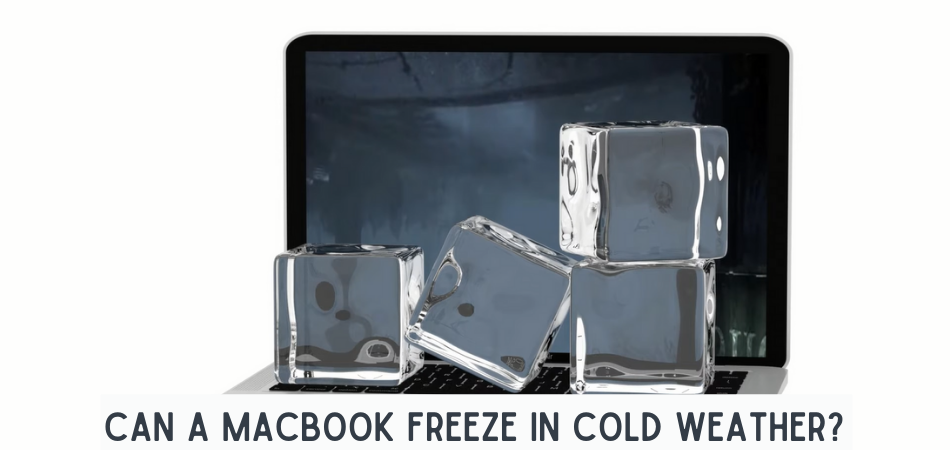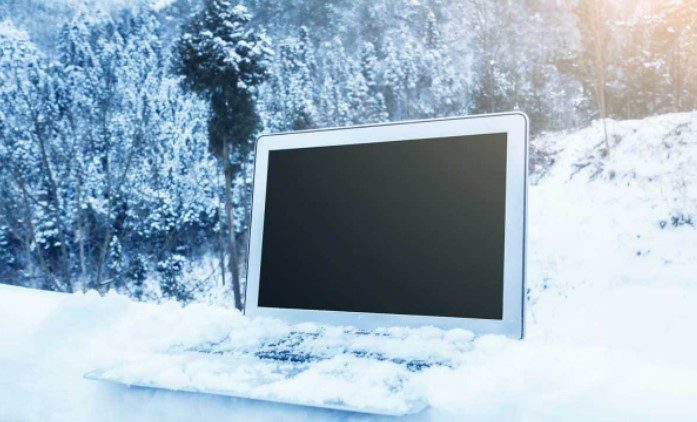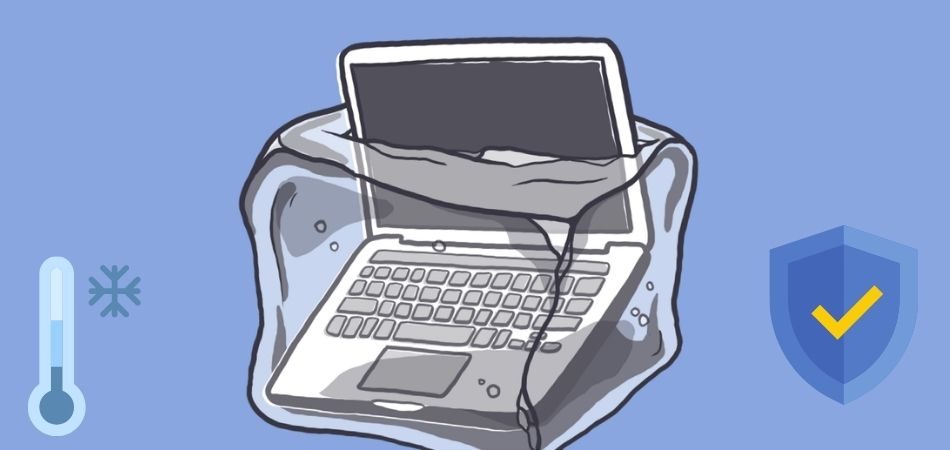
Usually, cold and extreme cold weather can pose a concern on mobile computing devices, including iPhones and iPads, and MacBooks. And this often begs the question, can a MacBook freeze in cold weather? While this may depend on factors such as the degree of cold, the Macbook’s temperature and icy surfaces, extreme cold weather tends to freeze a MacBook if exposed for too long.
Several tech concerns arise for low temperatures and mobile computing devices; battery performance alongside the screen. Lithium-ion batteries may fare well in the cold, to a point, since it slows down their discharge rate. However, cold temperatures can change the performance attributes, leading to trouble recharging. And the cold can make a battery lose some of its charges, up to as much as 40 percent.
Can A Macbook Freeze In Cold Weather?
If you’re wondering if a MacBook can free in cold weather, the short answer is yes. However, frost affects the metal components of the MacBook and it is known that cold also affects almost all its liquids; a MacBook consists of parts that contain liquid. An example of this is the LCD screen which can have the “liquid” frozen in icy conditions.

Macbook’s Temperature Guidelines
According to Apple, one should place the temperature of a MacBook’s surroundings between 50 °F and 90 °F (10 to 35°C). Temperatures above or below this range can harm a MacBook. Although the internal components of the MacBook run at temperatures warmer than the temperature of its surrounding(internal components has a minimum temperature of 40°C), the internal temperature should not exceed 192 °F (89°C).
The temperature of a MacBook can be monitored and maintained using utility apps such as “terminal” and others. The operator should enter a specific command in the terminal, followed by the admin password. A CPU temperature reading is then displayed and can get disabled by pressing Ctrl-C. An app called “Fanny” is handy here as it shows the CPU and GPU temperature and current fan speeds.
What Happens When A Macbook Gets Too Cold?
If a MacBook gets too cold, the following may occur:
The Battery May Get Affected
Storing lithium-ion batteries at very low temperatures can crack parts of the battery and separate them from surrounding materials, thereby reducing their electric storage capacity. Most batteries work through an electrochemical reaction, which sends power signals as an output. This reaction slows down in colder conditions, weakening the battery’s power.
Damage To Internal Components
When computers get too cold when switched off, their parts may get damaged during booting up because power warms up the circuit. As electric current moves along the circuit, it heats up and causes the contents to expand. Upon expansion, when close to other components that did not change in size, it distorts and can bend or break components.
Condensation Which Yields Water
In cold rooms, moisture can lead to condensation within the internal components of the MacBook due to the presence of water vapor in its surrounding. This water damages running electrical materials and may also cause short-circuiting of the internal components.
Read More: Why Is My Mac Volume So Low?
How To Stop A Macbook From Freezing In The Cold?
The following points are essential to consider when travelling in cold weather to keep your Macbook protected from the cold.

1. Safeguard Your Laptop When Traveling In Cold Weather
Exposure to cold comes present when traveling. Hence, one should protect a computer by keeping it in a well-insulated case when on the move, especially when the temperature drops below the freezing mark. Should the bag become wet, the MacBook would be exposed to moisture damage. Therefore, one should avoid turning on the MacBook until it is certain that the laptop is dry.
2. Avoid Keeping The Macbook In A Cold Place
Even if one has a laptop case that keeps the MacBook well protected, one should avoid leaving the laptop in an open space such as a trunk. If it is exposed to cold for an hour, the MacBook could freeze, and one could lose all data stored on it.
3. Time Should Be Allowed For The Laptop To Warm Up
When a MacBook is moved from freezing conditions outside to a warmer room inside, it should be left for at least a quarter of an hour before turning on. This is to enable it to be accustomed to the warmer temperature. If the MacBook is being turned on early, this could damage the screen and internal hardware to a great extent.
4. Avoid Its Use In Icy Conditions
While one may get away with using a MacBook in cold temperatures without any complications, sometimes, it may get damaged while attempting to do so. One should avoid using the MacBook in areas where the temperatures have dropped below freezing point. Hence, it is crucial to move into a car or a warmer shelter before turning the system on.
5. Make Use Of Laptop Warmers
A laptop heater or warmer is a device that heats your computer to suitable temperatures electronically. You can also use it to warm laptops in cold weather when the laptop isn’t used. Increasing the heat generated by the warmer is also possible by placing it and the computer in an open box.
6. Laptop Cases Can Be A Great Deal
Use a laptop case with insulation and padding to help prevent cold from building up in the computer. One should note that the device is still at risk of condensation and moisture damage while it’s in the case. Thus, it is still important to remove it from areas promoting high risks of cold damage.
5 Ways To Protect A Macbook In Cold Weather
Supposedly, one finds themselves in extremely cold environments, the following tips are important to note to protect a MacBook from seemingly cold temperatures.

1. A MacBook should not be left in a Cold Vehicle Overnight
Regardless of the season, it’s not wise to leave laptops in a car; it’s a terrible idea in the winter when cold temperatures can make the MacBook freeze in no time at all. Even while protected by a laptop bag or backpack, the cold winter air will make its way into every part of any electronic device. While it may be tough to juggle groceries, children, and a laptop bag at the same time, doing so can limit the chance of suffering damaging effects.
2. Avoid Icy Locations
Not sure what is considered cold enough to damage a battery? Most experts will agree that 40 °F is the breaking point when batteries degrade due to the cold. Where would it even be possible to use a laptop comfortably in such conditions? Unheated garages, attic spaces, or three-season porches can drop below 40 degrees during the winter. These locations should be avoided and laptops should be kept indoors instead.
3. Make Use of a Waterproof Laptop Bag
A waterproof laptop bag can effectively protect electronic devices all year long. The same bag that guards against rain in the spring and summer can help keep out moisture from the snow during the winter. However, these bags aren’t perfect. Leaving one in a snowbank or on the deck during a snowstorm will eventually allow moisture to find its way in.
4. Be Mindful of Surfaces
Excessive cold is not the only winter threat that affects MacBooks. Believe it or not, laptops are also prone to overheating during the winter. MacBooks overheat when the cooling vents on the bottom of the device become obstructed. Often, the surfaces on which they’re placed are to blame. Fluffy, heavy blankets can block vents. Hence, users should place their devices on a flat, smooth surface instead.
5. Avoid Condensation
One of the key ways one can cause damage to a computer is to move it too quickly from a very cold environment to a warmer one. This can cause condensation, which leads to moisture present within the device. When a MacBook is retrieved, one should not take it immediately into a hot place.
Final Words
MacBook users may be thrown to ask, can a MacBook freeze in cold weather? Typically, a laptop can freeze in cold weather if the environment’s temperature falls below zero degrees. However, it should be noted that only some places in the world experience outside sub-zero temperatures. Still, it doesn’t mean that one should become careless in storing and using a laptop. If the device comes in from a cold area, it should be properly thawed to avoid damage. Accessories, such as laptop cases and warmers, can also keep the computer warm in cold temperatures.